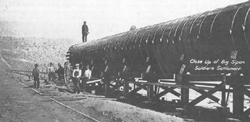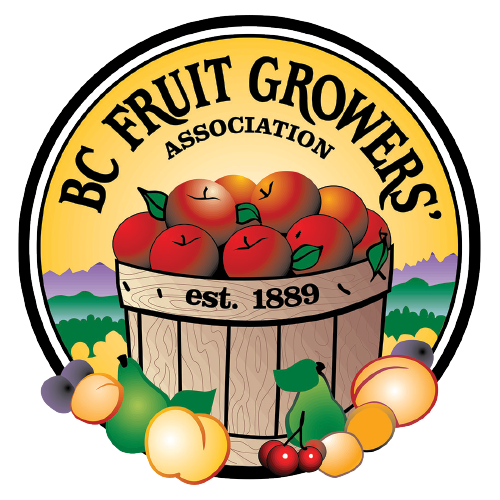Irrigation Problems
Many of the land and development companies in the southern Interior had economized on their irrigation systems, in order to start their subdivision with the minimum capital outlay. Most companies skimped by making do with temporary wooden flume systems which were just large enough to serve the area they expected to sell immediately. These systems would have to be totally replaced within eight to ten years as the wood deteriorated. The development companies expected that, within that time, profits on land sales would enable them to replace the wooden flumes with concrete systems, but with the drying up of business due first to the depression of 1913 and then to the Great War, few of them were in a position to complete the ambitious, permanent irrigation works they had promised. Indeed, many of the companies could not maintain their existing works-the Okanagan Falls Water and Irrigation Company went into receivership on May 14, 1915; the Kelowna Irrigation Company on May 28, 1915; and the South Kelowna Irrigation company declared voluntary liquidation by reason of insolvency on June 17, 1916.
Vignette: The Prince of Wales at the VFU
Vernon was a stop on the 1919 Canadian tour of Edward, Prince of Wales. He arrived from Penticton on the lake steamer S. S. Sicamous on the afternoon of Tuesday, September 30, and was whisked by car to Vernon City Park for a civic reception, including a mayoral address with all the school children of Vernon waving flags.
At the conclusion of the speeches and ceremonies, under a canopy shaped like a gigantic “O.K. Brand” apple, the Prince’s expressed interest in the famous Okanagan fruit growing industry was gratified by a visit to the newly completed Vernon Fruit Union building. Here packing was in full swing and Prince Edward was treated to a tour of the up-to-date facilities. The most modern pride and joy, it seemed, was a sizing machine which was an example of the “efficiency with which machinery could be made to answer man’s needs.” The machine had three cups into which the fruit dropped. Controlled by a weightmeasuring spring, the machine threw the apples to the appropriate places as it rotated!

Prince Edward was shown a basket of apples picked from a seedling tree growing in the orchard of A. Waring Giles, in the Coldstream, and was invited to name the new variety. With becoming modesty, he named it the “Prince Edward” apple, as a memorial to his visit.
By 1916 many growers saw “the danger of irrigation-works giving out any day”, and that year’s B.C.F.G.A. Convention called on the provincial government to “take immediate action towards complete and effective removal of the uncertainty of supply and future cost of irrigationwater to the farmer.”

Eventually the government was forced to step in, for it could not leave several thousand farmers with their livelihoods threatened. Straightening out the tangled mess of the organization of public irrigation districts which could take over and rebuild the systems from the irrigation companies took several years. For some developments it was too late; a quarter mile of the flimsy main flume at Walhachin washed out in storms during April, 1918. It was never rebuilt, and the fruit plantings were abandoned.

Right from the time in 1918 that the provincial government began giving loans for irrigation, the districts had difficulties in making payments, especially after 1930, and eventually much of the debt had to be written off by the government.
Vignette: The Big Ditch
The southern end of the Okanagan Valley did not participate in the pre-1914 fruit boom. A few scattered plantings were made; Leslie Flill laid out a forty acre orchard at Osoyoos in 1907 and Pete Mclntrye (for whom McIntyre Bluff is named) planted a small orchard where he homesteaded north of Oliver in 1892. But nearly all of the land was part of the vast Ellis cattle ranch, which stretched from the foot of Okanagan Lake to the American border. The Southern Okanagan Lands Company bought the property from Tom Ellis in 1905 and developed the area around Penticton for orchards, but it was not prepared to make the enormous investment necessary to supply irrigation further south.
Enter John Oliver, the premier of British Columbia. A farmer himself, he hoped to alleviate the problem of finding work for the soldiers returning at the end of the First World War by settling the veterans on the land. Under the provisions of the Soldiers’ Land Act of 1918, the provincial government bought 22,000 acres, stretching from McIntyre Bluff south to the American border, from the Southern Okanagan Lands Company. Operations to bring water to this tract commenced in 1919. The Southern Okanagan Lands Project, as it was officially known, was intended to create 8000 acres of irrigated land, which would be offered on special terms to returned soldiers.

A concrete-lined canal, drawing from the foot of Vaseaux Lake, was laid out, running twentythree miles southwards. Construction proved more difficult than originally forecast, with the result that the project was not finally completed until 1927, at an eventual cost of $3,237,200, more than triple the original estimate. Undoubtedly the most impressive part of the system was the enormous syphon built at Oliver in 1921 to carry the water across the valley. Made up of 1940 feet of woodstave pipe and 1620 feet of rivetted steel pipe, its diameter of 78 inches was large enough to allow repair workers to walk inside it.

The first irrigated land was sold and the first fruit trees were planted in 1921, and as the irrigation system was completed southward, additional areas were opened up for sale. But the expected rush of ex-soldiers anxious for farms did not materialize, so the government soon opened sales to the general public. Eventually six hundred lots, with an average size of eight to ten acres, were sold. By 1935 the farms and orchards of the area supported around 2500 people. Large quantities of apples, pears, and soft fruits were grown, as well as field crops. The field crops had originally been grown between the rows of young trees not yet producing, but they soon became major products in themselves: tomatoes, cantaloupes, cucumbers, and later the weird zucca melon, used for making candied peel, which grows, standing on end, up to four or five feet long.







